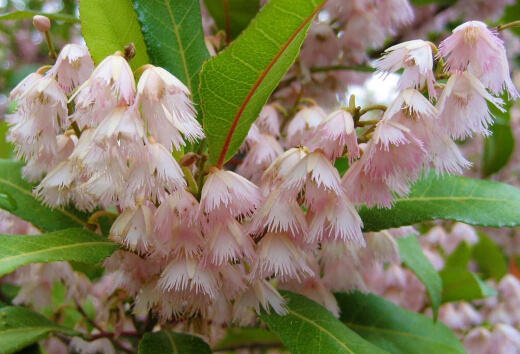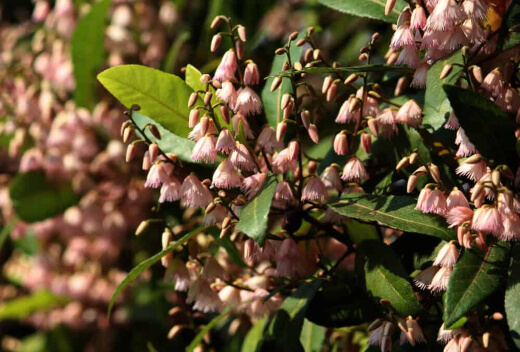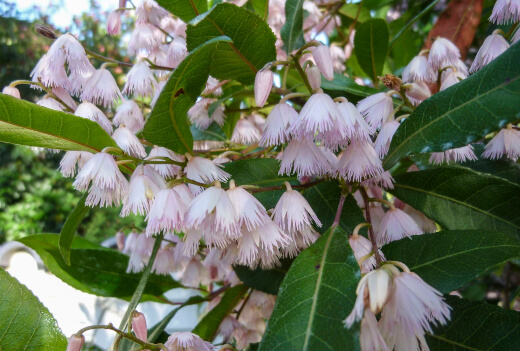A welcoming scent and pretty ‘bells’ make the Ash a charming addition to any garden. The tree is native to eastern Australia and needs little maintenance.
If you enjoy beautiful flowers and berries (and the birds they attract), you could grow Blueberry Ash (Elaeocarpus reticulatus) in a decorative pot, as a hedge or just a lovely standalone garden feature.
More...
Blueberry Ash Introduction

Source: Gardensonline.com.au
Elaeocarpus reticulatus – what does it mean? The name Elaeocarpus comes from the Greek word elaia which means olive, and karpos means fruit.
The name reticulatus is derived from Latin and refers to the ‘net-like’ veins that we see on the leaf. Common names include blue olive berry, fringe tree, lily of the valley tree, fairy petticoats, and prima donna.
Blueberry ash tree or shrub can grow quite tall and is evergreen. It has soft and frilly white or pink flowers that arrive in spring and early summer, and distinct blue berries that look a bit like olives.
We don’t suggest you eat them though. This tree/shrub bears fruit most of the year, starting after flowering and continuing into winter.
If a plant’s flowers have the nickname ‘Fairy Petticoats’, you can be sure it will be lovely. They look a bit like skirts or bells. And they smell good too, a scent similar to liquorice.
It’s nice to know that whatever the season, blueberry ash has an attractive flower or berry to brighten your garden. The leaves are beautiful too, especially as the plant begins growing. Shades of bronze and pink appear as young leaves which later become green when the plant matures.
How to Grow Blueberry Ash
Blueberry ash trees are narrow and grow slowly. They range in height from 8m-15m depending on conditions but only reach 3m-4m in width. Due to their narrow shape, they can be useful to create a garden screen or hedge.

Source: Nationalparks.nsw.gov.au
Propagating Elaeocarpus reticulatus
Your best bet is to propagate blueberry ash from a semi-hardwood cutting. Aim to take a cutting around February which is the warmer growing season. Cut a branch with quite a few leaf nodes and it should be 15-30cm in length.
Trim the bottom leaves off and dip the cut end into rooting hormone. You can then put the cutting in a container with a propagating mix. Remember to water the cutting well. This helps the soil settle.


Get Your Free Guide:
Master Growing Australian Natives eBook
A Must Have Complete Guide for Every Australian Garden
Get Your Free Guide:
Master Growing Australian Natives eBook
A Must Have Complete Guide for Every Australian Garden
Growing Blueberry Ash from seeds
It is possible to grow blueberry ash from a seed but it’s a longer process. It can take up to two years for a young plant to establish itself.
If you decide to go this route, you’ll want to sow the seed in spring or autumn. You’ll start off by soaking the seed for 3 to 4 days, changing the water daily.
Sow the seed at a depth of 3mm and place in a semi shaded area so it doesn’t dry out. You want the seed to be warm and moist – it shouldn’t dry out or become waterlogged.
Right Conditions for Growing Blueberry Ash Prima Donna
When thinking about the growing conditions for blueberry ash, you’ll need to consider soil, light and climate.
Soil Type
This Australian plant is happiest in sandy or loamy soil which needs to be neutral to slightly acidic. Clay soil is also a great option, just ensure it doesn’t remain waterlogged. Add a layer of mulch for good measure.
Blueberry ash needs soil that is consistently moist but also well-drained. It’s a delicate balance. If the tree gets too much water it will choke the shallow roots but will also throw off the nutritional balance of the plant.
Sunlight Requirements
This tree wants a good dose of vitamin D and will do best in a sunny position but can also be just as content in light or partial shade.
Climate
Blueberry ash doesn’t do well in colder climates. If you live in a mild area which experiences light frosts, you will need to protect the tree until it has matured. They’ll thrive best in subtropical and warm temperate areas, and they like the coast too.
Caring for Blueberry Ash tree

Source: Lawn.com.au
A plant or tree that needs very little maintenance is a gardener’s dream and blueberry ash is one of these. Once it’s established, it needs very little care.
Fertilising Blueberry Ash
Aim to feed the tree with a native fertiliser while young. The full-grown Blueberry ash can handle an organic fertiliser like mulch twice a year. (See our review on Yates fertilisers for some of the best fertliser options you can find online.)
Watering
Water your tree well while it’s establishing itself. Older plants can handle drought but you’ll need to do extra watering during the dry months.
A retractable hose reel might be the ideal choice for your garden. Check out our guide on retractable hose reels to learn more.
Pruning Blueberry Ash
You don’t need to do any pruning if you’re growing this plant as a tree. If it’s being used as a hedge or container plant, you can trim your blueberry ash after the flowers have wilted. (To get that perfect hedge, you'll need the best hedge trimmers here.)
When you do prune, proceed with caution. You never want to prune the main growing tip of the Elaeocarpus reticulatus. The tree’s response to pruning is often withholding re-growth.
This also applies to the side branches – wherever you cut, it’s going to remain like that. This is a little more permanent than a bad haircut so be sure before you snip.
Common Blueberry Pests and Diseases

Source: Resources.austplants.com.au
Blueberry ash are quite hardy and shouldn’t be too needy from a maintenance perspective. If you’re going to have any challenges, these are the things to look out for:
- Scale – these tiny insects look quite harmless and will appear as brown growth on the plant. On the underside of their shells though, they have attached themselves to the plant and suck its sap. The solution? You can spray the tree with an organic insecticide as required.
- Sooty mould – This fungus will make your tree’s branches and leaves look like it’s covered in black soot. The mould actually grows in the secretion of common plant pests.
That means you need to eliminate the pests on the plant to prevent more mould. Once this is done, you can then wipe the leaves and affected areas. Spraying the tree with something like neem oil is effective in eradicating the pests and the fungus.
It’s worth noting that sooty mould is more common in stressed trees – you might need to change your watering habits or improve the soil. - Caterpillars – if you start to notice that your tree looks a little less leafy than usual, you might have a caterpillar crisis on your hands. You wouldn’t usually have this issue with established trees but for a younger one, you can once again treat with neem oil.
- White film on leaves – white marks can develop as a line along the edge of the leaf or it might appear as a light coating all over. You’ll be relieved to know this is normal and nothing to worry about.
Blueberry Ash Tree Frequently Asked Questions

Source: Nationalparks.nsw.gov.au
Are the fruit of blueberry ash safe for pets to eat?
The berries from the blueberry ash are safe for dogs to eat and shouldn’t pose any health risks.
As with any bushfood, it is always advisable to monitor your dog after eating the fruits as there can always be outliers and I would also recommend mildly limiting intake so that your dog isn’t consuming too much at any given time.
Overall, though, there should be no health risks with these berries.
How long can a blueberry ash survive?
Elaeocarpus reticulatus has a good life span and can live up to 50 years.
Can you eat the fruit?
The outer skin and soft inner layer of the fruit is safe to eat, excluding the seed. The fruit is used in Australian Aboriginal Cuisine to make things like Bush tucker tea and is used in making jam.
You’ll find the best fruit hanging from the underside of the tree and if it’s wrinkled, you know it’s going to taste good. If the fruit is bright blue, you can eat it raw.
Is blueberry ash a tall tree?
Blueberry ash grows 3–15 m tall but when found in one of the rainforests in New South Wales or Queensland, it can grow to a height of 30 metres.
Can blueberry ash grow anywhere?
Blueberry ash is a hardy plant and grows under many conditions. It originates from rainforest environments like southeastern Queensland, eastern New South Wales, and on Flinders Island in Tasmania.
Over time, the tree has adapted to grow in the drier climate of south-eastern Australia. In New South Wales it grows in moist areas, Eucalyptus forests and sandy coastal scrub.
What kind of birdlife does the tree attract?
The Regent bowerbird collects the fruits for their blue colour. Other birds that eat these fruits are Wonga Pigeons, Crimson Rosellas, Figbirds and White Headed Pigeons.
Does blueberry ash really stop fires?
Elaeocarpus reticulatus is fire retardant – this refers to plants that will not ignite easily in a moderate intense bush fire. If it ignites during a big bush fire, this tree would burn slower.
Looking to grow more native plants? See our Dianella revoluta (Blueberry Lily) Growing Guide

Enhance your Garden's Unique Charm with Blueberry Ash
Elaeocarpus reticulatus is pleasing to the eye and requires minimal work. It will look lovely most of the year round, attract some interesting visitors, and be sizable enough to make a statement. Blueberry ash certainly gets our thumbs up!
Published on February 6, 2022 by Nathan Schwartz
Last Updated on January 19, 2025





Hi Gary,
I have a Blueberry Ash about 2.1m high. Planted about 8 months ago as mature tree. It has been growing very well. The soil here at Bundaberg is heavy clay so dug big hole and put mixed compost & manures in. Last week got heavy rain and now the leaves are drooping down and some a curling inwards – it looks sick.
Can you suggest a way to save it – could it just recover on it’s own? I understood it was hardy.
Thanks for any tips Gary
Kind regards
Beth
Hi Beth,
Sorry to hear about your struggling blueberry ash. In most scenarios, these trees can recover on their own in good conditions, but a little extra attention can also go a long way.
It’s great that you have lightened up your soil as these trees do prefer sandy or loamy well-draining soil. However, due to the heavy rains you mentioned, it is very possible the clay-based soil has overly compacted itself and the tree is now being slowly suffocated, that would help explain why it looks sickly.
I would recommend that you aerate your soil every so often to keep it draining sufficiently. Digging in some compost, manure or perlite occasionally will also help to keep the soils breathability in check.
Under stress, it’s normal for a blueberry ash to lose its leaves and branches. You can try lightly pruning away some of the dead and dangling branches to encourage healthier new growth. It may also be worth feeding your tree a native fertiliser for an added boost.
I’m sure your tree will be able to bounce back in no time. Hope this helps. Happy gardening!
Gary Clarke
Are the fruit of Blueberry Ash safe for pets to eat? specifically, dogs
Hi Paul,
Thanks for your question.
After extensive research, it seems that the berries from the blueberry ash are safe for dogs to eat and shouldn’t pose any health risks.
As with any bushfood, it is always advisable to monitor your dog after eating the fruits as there can always be outliers and I would also recommend mildly limiting intake so that your dog isn’t consuming too much at any given time.
Overall, though, there should be no health risks with these berries.
Enjoy your beautiful bush tucker and have a fantastic week further.
Nathan Schwartz
Hi,
Planted a fairly mature Blueberry Ash last year, here in Adelaide. I think it is doing well, and today I noticed many little 'branches'/twigs-like growths spurting from the base of the trunk. Should I prune these off as I don't want it 'bushy', but a beautiful tree?
Thanks,
Margaret
Hi Margaret,
There are a few reasons this will happen on trees, but if you’re after a clean trunk and an elegant upright tree, then prune them out.
One thing worth checking is that the foliage on the suckers (the small branches at the base) matches the foliage on the rest of the tree. It’s unusual for blueberry ashes to sprout right at the base unless there’s some damage, so I’m wondering if it’s grown as a grafted rootstock. It’s unlikely on native blueberry ash, but not unheard of.
Again, either way, just keep on top of pruning. It might keep sending the suckers up, but the more mature the tree gets, the less frequently it’ll happen. Clean your secateurs before and after cutting, just to limit the risk of bacteria or fungus getting in around the base of the trunk.
Best regards,
Gary Clarke
Hi Nathan
I am looking for a recipe for Blueberry Ash jam – without success.
Our trees are now in bloom and I’m hoping to make some jam when the berries are ripe.
Regards
David Johnston
Carlingford NSW
Hi Nathan
I am looking for a recipe for Blueberry Ash jam – without success.
Our trees are now in bloom and I’m hoping to make some jam when the berries are ripe.